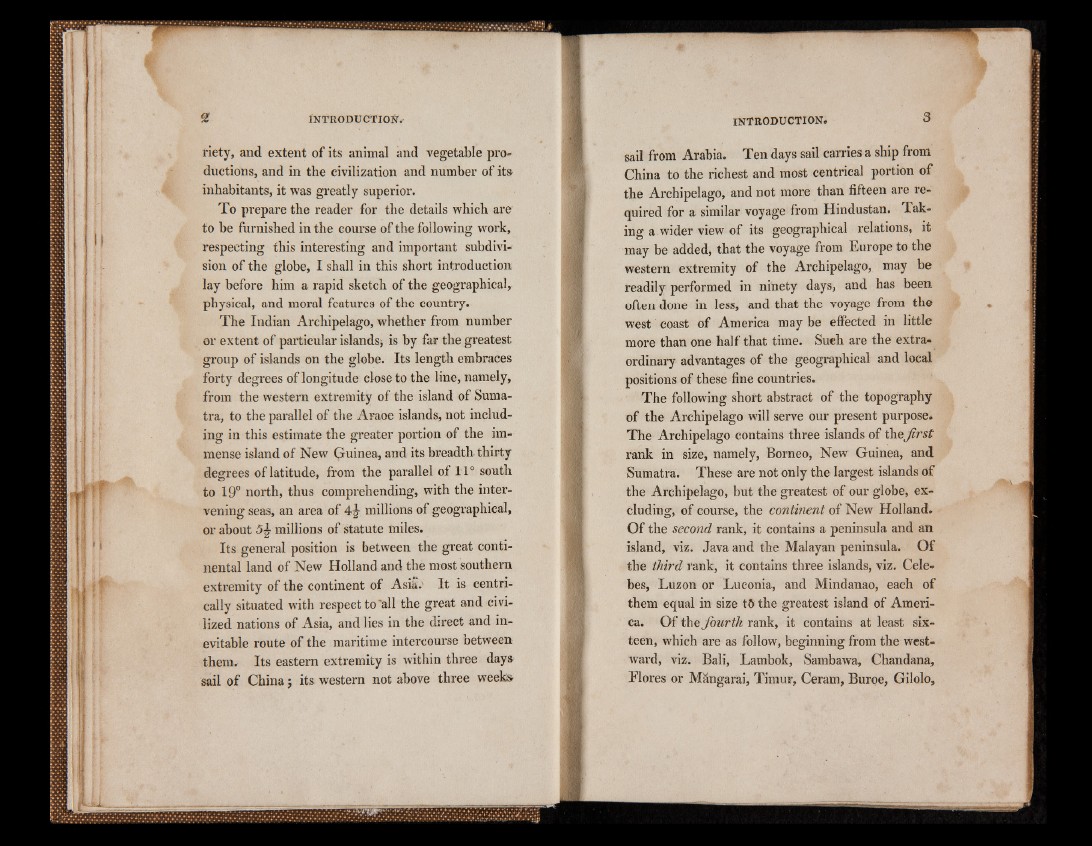
riety, and extent of its animal and vegetable productions,
and in the civilization and number of it»
inhabitants, it was greatly superior.
To prepare the reader for the details which are
to be furnished in the course of the following work,
respecting this interesting and important subdivision
of the globe, I shall in this short introduction
lay before him a rapid sketch of the geographical,
physical, and moral features of the country.
The Indian Archipelago, whether from number
or extent of particular islands* is by far the greatest
group of islands on the globe. Its length embraces
forty degrees of longitude close to the line, namely,
from the western extremity of the island of Sumatra,
to the parallel of the Araoe islands, not including
in this estimate the greater portion of the immense
island of New Guinea, and its breadth thirty
degrees of latitude, from the parallel of 11° south
to 19° north, thus comprehending, with the intervening
seas, an area of millions of geographical,
or about 5^ millions of statute miles.
Its general position is between the great continental
land of New Holland and the most southern
extremity of the continent of Asia.’ It is centri-
cally situated with respect to'all the great and civilized
nations of Asia, and lies in the direct and inevitable
route of the maritime intercourse between
them., Its eastern extremity is within three day»
sail of China j its western not above three weeks-
¡sail from Arabia. Ten days sail carries a ship from.
China to the richest and most centrical portion of
the Archipelago, and not more than fifteen are required
for a similar voyage from Hindustan. Taking
a wider view of its geographical relations, it
may be added, that the voyage from Europe to the
western extremity of the Archipelago, may be
readily performed in ninety days, and has been
often done in less, and that the voyage from the
west coast of America may be effected in little
more than one half that time. Such are the extraordinary
advantages of the geographical and local
positions of these fine countries.
The following short abstract of the topography
of the Archipelago will serve our present purpose.
The Archipelago contains three islands of tloefrst
rank in size, namely, Borneo, New Guinea, and
Sumatra. These are not only the largest islands of
the Archipelago, but the greatest of our globe, excluding,
of course, the continent of New Holland.
Of the second rank, it contains a peninsula and an
island, viz. Java and the Malayan peninsula. Of
the third rank, it contains three islands, viz. Celebes,
Luzon or Luconia, and Mindanao, each of
them equal in size tft the greatest island of America.
Of the fourth rank, it contains at least sixteen,
which are as follow, beginning from the westward,
viz. Bali, Lambok, Sambawa, Chandana,
Flores or Mangarai, Timur, Ceram, Buroe, Gilolo,